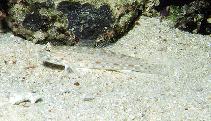| Family: |
Gobiidae (Gobies), subfamily: Gobiinae |
| Max. size: |
10.8 cm TL (male/unsexed) |
| Environment: |
reef-associated; marine; depth range 0 - 30 m |
| Distribution: |
Western Pacific: Philippines and Indonesia to Kiribati and Fiji, south to Rowley Shoals in the eastern Indian Ocean and the Great Barrier Reef. Reported from the Ryukyu Islands (Ref. 559). |
| Diagnosis: |
Dorsal spines (total): 7-7; Dorsal soft rays (total): 10-11; Anal spines: 1-1; Anal soft rays: 9-10; Vertebrae: 26-26. Upper pectoral fin rays entire. Predorsal with 7-9 cycloid scales; trunk with ctenoid scales. Segmented and non branching caudal rays 4, branching 13. Body color yellowish white; 2 brown diagonal lines from preoperculum to upper jaw, connected by a single line; 2 almost vertical brown lines on operculum. 4th spine of 1st dorsal fin longest. No sharp distinction between sexes in pigmentation and elongation of 2nd dorsal, pelvic and anal fins. Males sometimes with 3-4 dusky vertical bars on abdomen (Ref. 420); fully united pelvic fins with well-developed frenum; longitudinal scale series 29-32; predorsal scales 7-9, reaching interorbital space; absence of scales on cheek or opercle; depth of body 4.7-6.1 in SL (Ref. 90102). |
| Biology: |
Solitary (Ref. 90102). Occurs in sandy areas with living corals and coral rubble in clear waters, Ref. 48637. |
| IUCN Red List Status: |
Least Concern (LC); Date assessed: 27 January 2009 Ref. (130435)
|
| Threat to humans: |
harmless |
| Country info: |
Museum: TCWC 3263.1; USNM 254288 (Ref. 420). Also Ref. 420. |
Source and more info: www.fishbase.org. For personal, classroom, and other internal use only. Not for publication.

